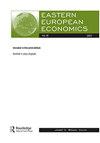用汉堡经济学研究土耳其的收入和工资不平等
IF 1.2
4区 经济学
Q3 ECONOMICS
引用次数: 0
摘要
摘要本研究深入探讨了土耳其多方面的不平等问题,分析了劳动力市场的整体和区域差异以及工资和性别不平等。通过巨无霸指数的视角,我们调查了购买力,并发现2002年至2020年间地区不平等的减少。然而,我们的研究结果表明,资本所有者或在职富人与工人之间的收入差距正在扩大,这在2015年之后尤为明显。此外,自2018年货币危机以来,男女白领之间的工资差距有所扩大,而男女蓝领之间的工资差距有所改善。关键词:巨无霸指数汉堡包分类:D31J71披露声明作者未报告潜在的利益冲突。经济合作与发展组织https://www.economist.com/big-mac-index3。截至2021年,土耳其有81个城市。每个城市都有自己的首都和自己的州长,他们由民选政府任命。土耳其的城市是由中央政府通过立法建立的,其中包括进行研究,与当地官员协商,并向议会提交提案以获得批准,之后任命一名州长来监督行政和服务。https://data.tuik.gov.tr/bulten/index?p=gelir - ve - yasam kosullari arastirmasi - 2021 - 455815。https://data.tuik.gov.tr/bulten/index?p=income -和-生活-条件-调查- 2020 - 37404 - &dil=26。Akarsu (Citation2022)修改了基尼系数,我们使用了该版本的基尼系数。在本研究中,除附录8中的图A1外,其余图均为我们自己的绘图和计算。由于数据限制,我们无法衡量土耳其城市内部的不平等程度。我们使用的术语是“资本家”和“工薪阶层”,这是皮凯蒂(Citation2015)在分析收入不平等和财富分配的书中引入的。马克思(Citation1875)以前曾使用“资本家”一词来描述资本和生产资料的所有者。此外,包括Piketty (Citation2015)和Godechot (Citation2016)在内的许多学者都使用了“working rich”一词来指代那些通过工作而非投资或继承获得高收入的个人。这些术语已经成为关于收入不平等的讨论的一部分,现在在学术研究和公众讨论中广泛使用。本文作者mahmut Zeki Akarsu是华沙大学经济学博士候选人。主要研究方向为宏观经济学和发展经济学。他目前的研究重点是美国和中等收入国家的工资和收入不平等,以及历史不平等、性别不平等、巨无霸负担能力指数、政治经济和土耳其经济等问题。本文作者是蒙特克莱尔州立大学经济学助理教授。她的研究兴趣包括应用计量经济学、统计学、收入不平等和劳动经济学。她在纽约城市大学获得博士学位。Vidya Atal是蒙特克莱尔州立大学的经济学教授。她的研究兴趣包括研究产业组织的各种主题,例如,美国的专利政策,开源软件许可,公司在专利竞赛中的策略或研究他们在研发中的投资决策。此外,她发现《发展经济学》中的几个话题非常有趣,如妇女赋权、家庭内部讨价还价、性别差距等。她拥有康奈尔大学经济学硕士和博士学位。本文章由计算机程序翻译,如有差异,请以英文原文为准。
An Investigation of Income and Wage Inequality in Turkey Using Burgernomics
ABSTRACTThis study delves into the multifaceted issue of inequality in Turkey, analyzing overall and regional disparities as well as wage and gender inequalities in the labor market. Through the lens of the Big Mac Index, we investigate purchasing power and discover a decrease in regional inequality between 2002 and 2020. However, our research findings indicate a widening income gap between capital owners or the working rich and workers, particularly evident after 2015. Moreover, the wage gap between male and female white-collar workers has widened since the 2018 currency crisis, while the gap between male and female blue-collar workers has shown improvement.KEYWORDS: Big Mac IndexBurgernomicsInequalityTurkeyJEL CLASSIFICATION: D31J71 Disclosure statementNo potential conflict of interest was reported by the authors.Notes1. Organisation for Economic Co-operation and Development.2. https://www.economist.com/big-mac-index3. As of 2021, Turkey has 81 cities. Each city has its own capital and its own governors, who are appointed by the elected government. Cities in Turkey are established by the central government through legislation, which involves conducting research, consulting with local officials, and submitting a proposal to parliament for approval, after which a governor is appointed to oversee administration and services.4. https://data.tuik.gov.tr/Bulten/Index?p=Gelir-ve-Yasam-Kosullari-Arastirmasi-2021–455815. https://data.tuik.gov.tr/Bulten/Index?p=Income-and-Living-Conditions-Survey-2020–37404&dil=26. Akarsu (Citation2022) modified the Gini index, we have used that version of the Gini index.7. In this study, every figure is our own plot and calculation except for Figure A1 in the Appendix.8. Due to data limitations, we cannot gauge inequality within Turkish cities.9. We use the terms “capitalists” and “the working rich,” introduced in Piketty’s (Citation2015) book, which analyzes income inequality and wealth distribution. Marx (Citation1875) had previously used the term “capitalist” to describe the owners of capital and means of production. In addition, the term “the working rich” has been employed by various scholars, including Piketty (Citation2015) and Godechot (Citation2016), to refer to individuals who have high incomes from work rather than investment or inheritance. These terms have become part of the discourse on income inequality and are now widely used in academic research and public discussions on the subject.Additional informationNotes on contributorsMahmut Zeki AkarsuMahmut Zeki Akarsu is a Ph.D. candidate in economics at the University of Warsaw. His research interests encompass macroeconomics and development economics. His current focus is on wage and income inequality, both in the United States and in middle-income countries, as well as on issues such as historical inequality, gender inequality, the Big Mac Affordability Index, the political economy, and the Turkish economy.Orkideh GharehgozliOrkideh Gharehgozli is an assistant professor in economics at Montclair State University. Her research interests encompass applied econometrics, statistics, income inequality, and labor economics. She earned her Ph.D. from the City University of New York.Vidya AtalVidya Atal is a professor of economics at Montclair State University. Her research interests include studying various topics of Industrial Organization, for example, the patent policies in the United States, open source software licensing, firms' strategies while in the patent-race or studying their investment decisions in R&D. In addition, she finds several topics in Development Economics very interesting, like women's empowerment, intra-household bargaining, gender gap, etc. She holds a Master's and a Ph.D. degree in economics from Cornell University.
求助全文
通过发布文献求助,成功后即可免费获取论文全文。
去求助
来源期刊

Eastern European Economics
ECONOMICS-
CiteScore
2.20
自引率
9.10%
发文量
32
期刊介绍:
Eastern European Economics publishes original research on the newly emerging economies of Central and Eastern Europe, with coverage of the ongoing processes of transition to market economics in different countries, their integration into the broader European and global economies, and the ramifications of the 2008-9 financial crisis. An introduction by the journal"s editor adds context and expert insights on the articles presented in each issue.
 求助内容:
求助内容: 应助结果提醒方式:
应助结果提醒方式:


